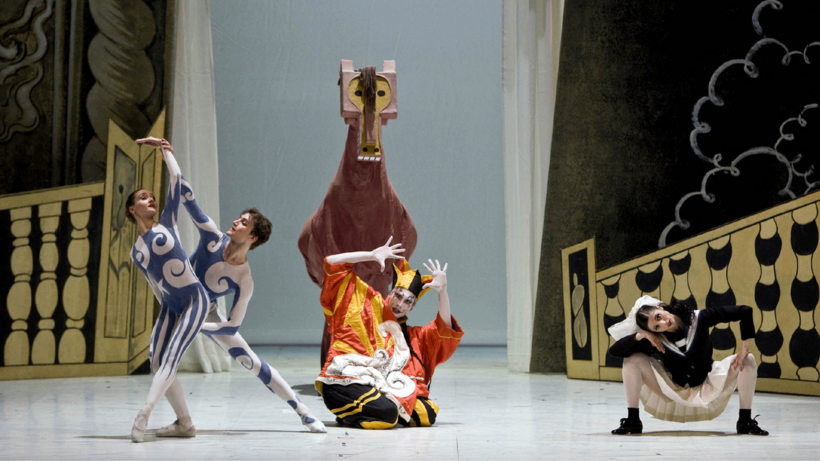Bonbons from the Ballets Russes under the stars at the foot of Vesuvius. Barring volcanic eruptions, what better formula for euphoria? With Parade (1917) and Pulcinella (1920), filmed in July 2017 at the Large Theater in ancient Pompeii, the dance ensemble of the Teatro dell’Opera di Roma offers a double bill of just this description.
Founded in Paris in 1909 and active through 1929, the touring “Russian Ballet” was the creation of Serge Diaghilev, a Russian expat with a genius for reeling in the city’s fizziest talents. Cocteau pitched in as the idea man for Parade, which had circusy music by Erik Satie and Cubist designs by Picasso. Back onboard for Pulcinella, Picasso took his cues from the same sunny 18th-century Neapolitan aesthetic that inspired Stravinsky. And the choreographer? Léonide Massine—the young actor from Moscow whom Diaghilev had recruited as his lover and star after his historic liaison with Vaslav Nijinsky, self-styled “fool of God,” went smash.

Hard-core dance aficionados may remember Massine from the beloved ballet movie The Red Shoes (1948), in which he appears and dances as the choreographer of a company very much like Diaghilev’s. Revivals of Massine’s boffo Gaîté Parisienne crop up from time to time, sometimes costumed by Christian Lacroix. But there was more to Massine than ooh-la-la operetta on pointe. His ambitious ballets to full-length symphonic scores, for instance, were far ahead of the curve. Might they be revived? Today, Massine’s legacy is overshadowed (as whose is not?) by that of his junior Ballets Russes colleague George Balanchine. That might be our loss.

Parade consists of a suite of teasers for a vaudeville show, performed on a sidewalk outside a theater. The ballet was precision-tooled to scandalize, as Le Sacre du Printemps had done four years before. And so it did—not by visceral shock this time, but by tweaking the stuffy clientele by the nose. Modeled on the commedia dell’arte, Pulcinella juggles multiple pairs of lovers, a quartet of clowns impossible to tell apart, a chorus line of clown nanos, and a charlatan magus. Good luck sorting out the story line! But who cares? As restaged in Pompeii by Massine’s son Lorca, the contrasting choreographic styles of Parade and Pulcinella are alike in this: both deliver delights and surprises in a nonstop flow of crisp, spicy dance images.
What’s more, there are Easter eggs in the form of what many a balletomane would swear are tips of the hat to Balanchine. In Parade, aren’t the acrobats quoting moves from the Apollo pas de deux for the god and his favorite muse? And when Pulcinella flashes through the sky like an eagle on attack, isn’t that a brazen steal from Prodigal Son? Not at all. The debt, if there is one, goes the other way. Apollo and Prodigal Son, the oldest surviving Balanchiniana in the canon, postdate the Massine curios by a good decade.
It’s worth mentioning that for New York City Ballet’s epic Stravinsky Festival of 1972, Balanchine gave Pulcinella a total makeover. The Massine, he opined in The New York Times, “was very boring, and besides, Picasso took over.” Mr. B’s new libretto involved a Faustian deal with the devil. The choreography got an assist from Jerome Robbins, who also joined the boss onstage as one of a pair of extraneous beggars. Eugene Berman designed lavish sets and costumes, sparing no expense. The premiere was a mess, though some critics tried to pretend otherwise. A much-revised revival (minus the beggars) fizzled outright. But here is Massine’s, and it sparkles.
Lorca Massine’s Parade and Pulcinella are available to stream on the medici.tv Web site
Matthew Gurewitsch writes about opera and classical music for AIR MAIL. He lives in Hawaii

